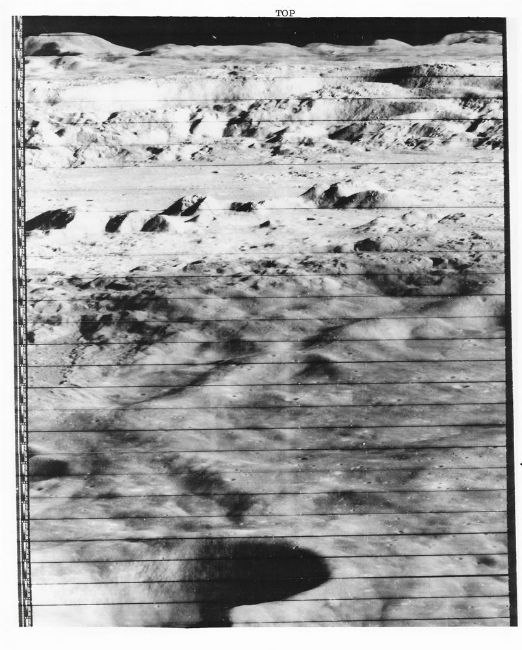Space Mission
Lunar Orbiter II, 24 November 1966
Photographer
Nasa
Photo Description
Vintage gelatin silver prints on fibre-based Kodak paper, 20.5 x 25.3 cm (10 x 8 in), with NASA captions on verso
Essay
This historic photograph was taken with the 610mm high resolution telephoto lens featuring a dramatic northward view inside the majestic 93-km wide and 3.8 km deep Crater Copernicus (latitude 10° N, longitude 20° W), hailed at the time as “The Picture of the Century.”
The 12-km keyhole shaped Crate Fauth is at the bottom of the photograph, the Carpathian Mountains at the top. Characteristics of the landscape are clearly shown by the shadows produced by the rising Sun, whose elevation was approximately 10 degrees above the horizon. Numerous mounds are visible on the floor of Copernicus, in addition to the central peaks.
On first seeing this oblique view of the crater Copernicus I was awed by the sudden realization that this prominent lunar feature I have often viewed by telescope is a landscape of real mountains and valleys, obviously fashioned by tremendous forces of nature.
—Oran Nicks, NASA office of Space Flights and Applications (Cortright, pg. 88)
The view that left millions in awe when it was released. The central peaks are in the middle of the image, rising as high as 1.2 km above the crater floor, and stretching for about 15 km. The northern wall of the crater is in the background.
Between 1966 and 1967 NASA sent five Lunar Orbiter spacecraft to the Moon. Their job was to survey the surface to help determine landing sites for the upcoming Apollo missions. In addition to their recon role, these spacecraft also significantly contributed to our scientific understanding of the Moon. They also captured photos of this nearby world that human eyes had never seen before.
One such image was taken of crater Copernicus on 24 November 1966 by the Lunar Orbiter II spacecraft. What made this photo so unique was the oblique angle it was taken at as well the close proximity of the spacecraft to its target. The image was taken at an altitude of 45 km (27.1 miles) at a distance of approximately 207.7 km (125 miles) from the center of the crater. Instead of looking down, the spacecraft looked sideways at the Moon.
For the first time people saw the Moon as a world with mountains and boulders and other features (some of them strange) that were not apparent from photos where the view was looking straight down. Life Magazine called the photo “The Picture of the Century.” Along with the equally famous Earthrise image taken by Lunar Orbiter I, the Moon went from being a distant sight in the sky to a world waiting to be explored.
